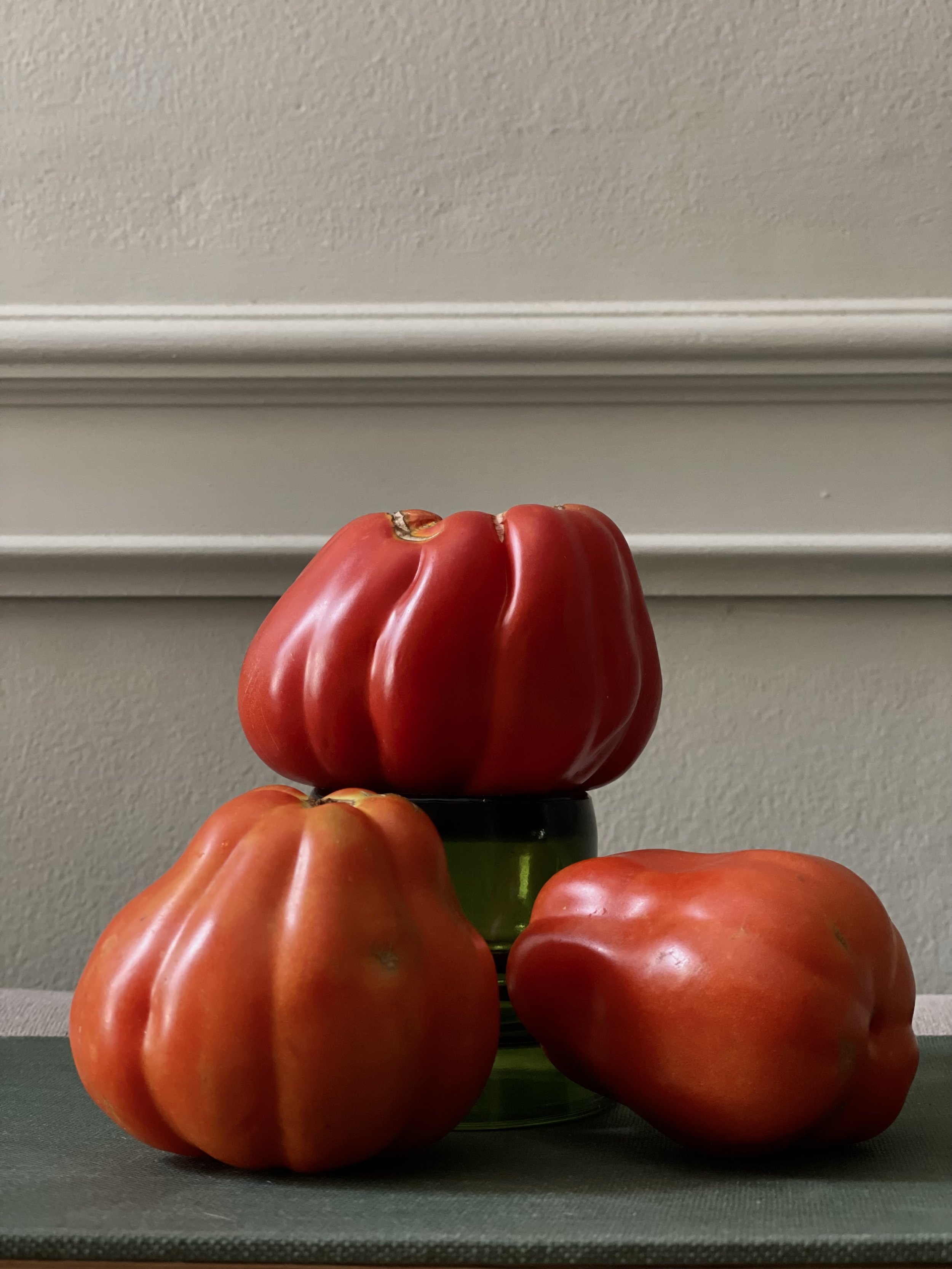The Italian Vegetable Primer: Sauce Tomatoes
Top clockwise: ‘Canestrino di Lucca’, ‘Opalka’, ‘San Marzano’. ‘Enrica Cimelo Toscana’
Sauce tomatoes never figured in Chinese or Taiwanese cuisine; even the tomatoes used in 番茄炒蛋 or Xī Hóng Shì Chǎo Jī Dàn/西红柿炒鸡蛋 are typically medium to large varieties sold in supermarkets. We would grow tomatoes in our gardens, but they either were consumed fresh with salt, black pepper, and olive oil or cooked lightly in stir fry dishes. Any paste or sauce tomatoes that ever touched our diets were the occasional spaghetti meal or the Italian American dinner on a night out.
‘San Marzano’ has become the de-facto paste tomato for processing, and it rode on the popularity of Italian and Italian American cuisine in US. Its elongated, curvaceous profile with its tapered neck became emblazoned on the can and jar labels, making it a recognizable talisman of Italian pride and hallmark of their cuisine. According to Amy Goldman’s The Heirloom Tomato (2008), genetic studies have pinpointed the probable parents of ‘San Marzano’ to be ‘Fiascone’ (‘King Humbert’) and ‘Fiaschetta’; commercial production did not commence until 1940s. Eaten fresh, it is rather mealy and tasteless even when ripened fully. Blandless aside, ‘San Marzano’ here fails to achieve the unami-heavy rich flavor in my home-made sauces or conserves. The plants are prolific, but somehow the terroir of the Mid Atlantic does not match that of southern Italy where the combination of warm dry days and cool nights, volcanic soils, and possibly locally adapted strains yield that unmistakable flavor of the peeled whole canned tomatoes we reach for during winter. Nonetheless, the popularity of ‘San Marzano’ has not wavered if the scores of tomato seedlings sold each spring in garden centers and big box stores are any reflection. There are better sauce or cooking tomatoes for this climate that trumps ‘San Marzano’.
‘Opalka’, a Polish variety that reportedly originated in 1900, is one of my top favorites for cooking and fresh eating. As pointy and crooked as a witch’s nose can be, this tomato is a low-moisture type, being more fleshy and denser than ‘San Marzano’. Arguably the wispy-leafed plants are not very prolific producers, and the fruits are susceptible to blossom-end rot if not consistently watered or well fed. However, their larger size (5” long to 3” wide for bigger fruits) can be equivalent to two ‘San Marzano’. The flavor is intensely savory, making for an addictive sauce that sings of summer sunshine. I know that Eckerton Hill sells boxes of ‘Opalka’ at the Union Square Greenmarket –last year when I grew no tomatoes, I craved ‘Opalka’ and had to settle for a few. The box would have been impractical for someone traveling on public transport.
‘Canestrino di Lucca’ tomatoes
A few years ago, I bought ‘Canestrino di Lucca’ from the Union Square Greenmarket stall of the recently retired Rick Bishop of Mountain Sweet Berry Farm near Roscoe NY in the Catskills. Their bell shapes –fat, squat, and ribbed— was unlike those of egg-like or pointy forms of other tomatoes I was used to. Indeed, the name translates to ‘little basket’. I turned my modest haul of ‘Canestrino di Lucca’ into a cold tomato soup using a recipe from Honey & Co – and immediately I was a converted fan. I looked for this variety unsuccessfully since then, and soon my futile search consigned it to my mental culinary canon of memorable tastings, something to dream about again. Last May at the local farmers market, I chanced upon a stallholder selling surplus vegetable seedlings. Angling for a sale, he struck up a conversation during which we discussed sauce tomatoes and what we regarded as the best for processing. I was nudged gently to plants labeled ‘Canestrino di Lucca’ and was convinced to purchase two, despite seemingly unaware that this tomato and I had crossed paths previously. I did harbor some skepticism about growing a cultivar seemingly suited to more temperate Tuscany than humid and hot mid-Atlantic. Early blight and a raft of diseases had dented my enthusiasm for growing heirloom tomatoes. I was surprised to see the plants outpacing ‘San Marzano’ and ‘Opalka’. The yield was comparable to ‘San Marzano’, but overall the plants were healthier.
Outside of Italy, ‘Canestrino di Lucca’ will never appeal to consumers who are accustomed to the perfect red orbs passing as tomatoes. For one reason, it has green shoulders at the ripe stage. Even its pale red color can be off-putting. ‘Canestrino di Lucca’ challenges us to consider inside its ‘heart’. Sliced open, it is a vibrant red with no thick core, little seeds, and very low moisture content. There is a perceptible aroma that hints at the goodness that will come once married to slow heat of cooking. In 2015, Italy took measures to protect ‘Canestrino di Lucca’ from extinction in its Presidi Slow Food/Register of Biodiversity for the Tuscan region.
Several other sauce tomatoes have come to my attention, although the flavor of the few being grown now awaits future assessment as the fruit ripens this month. ‘Cipolla’s Pride’ was introduced to US through a Sicilian immigrant named Anthony Cipolla in 1906, and his son Larry maintained the germplasm. Its fruits are plum-type, and are said to be good either cooked or eaten fresh. ‘Purple Beech’ shares the same Italian heritage as ‘Cipolla’s Pride’, having been brough to Vermont during WWII. The fruits are elongated like ‘San Marzano’, tapering towards the end like ‘Opalka’, but not as pointy. ‘Tiren’, despite not being a heirloom tomato, offers the disease resistance that its predecessors lack. A friend alerted me to ‘Ten Fingers of Naples’ recognizable for its long trusses reminiscent of its namesake appendages. It would be preferable to seek these varieties at a farmer’s market –regretfully tomatoes often are not labeled and simply given the generic ‘heirloom tomatoes’ unless one engages with the grower. More disappointingly, the fame of ‘San Marzano’ continues to eclipse others waiting for their culinary moment.







